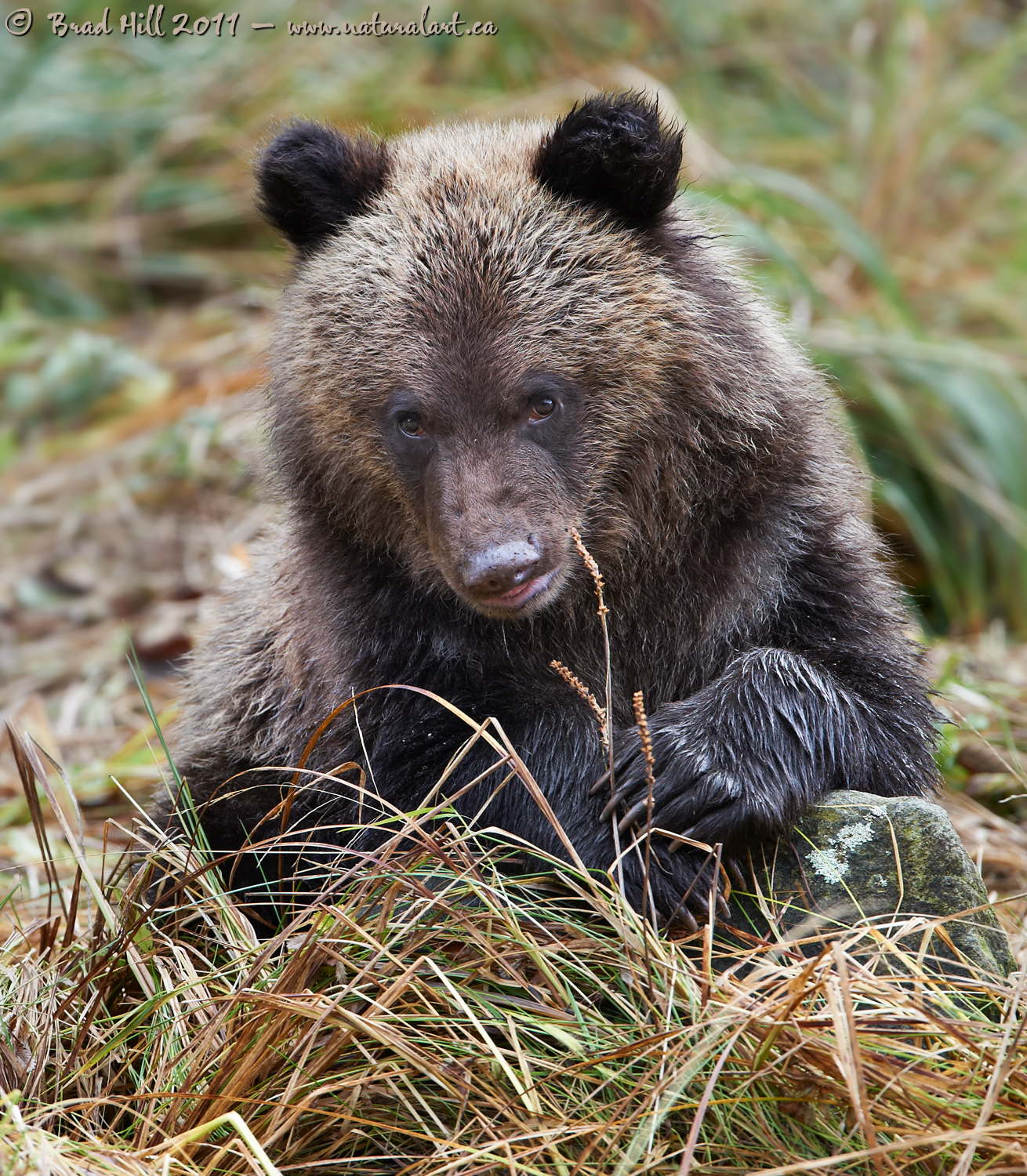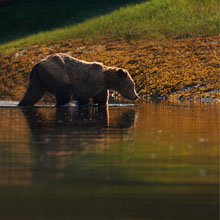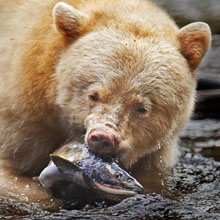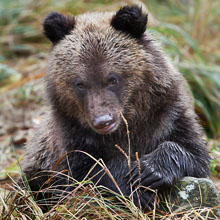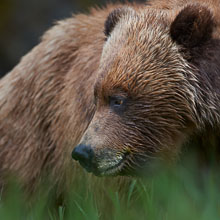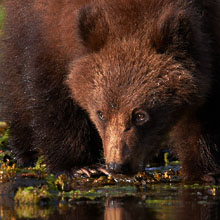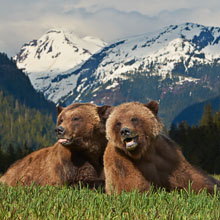Availability: Undetermined - Enquiries?
In the Field
Resonance and the Cute Factor. Great Bear Rainforest (central BC coast), BC, Canada. October 2, 2009.
There's a valid reason why many children's plush toys are modeled after bear cubs (those fluffy teddy bears) - the real McCoys are just so darned cute! And so, so full of personality...
I consider myself to be a conservation photographer first, and a wildlife photographer second. A lot of the wildlife images I shoot are destined for some form of use in conservation campaigns, either by selected conservation organizations or even sometimes "just" on this website. It's my belief that wildlife images CAN be effective in influencing public opinion on conservation issues, but only if the viewer somehow identifies with the subject. Another way of saying this (CAUTION...major buzzword alert!) is that the image has to strike a chord with viewer...it has to somehow resonate with them...they have to be able to relate to it, etc. I strongly believe if you are able to capture an animal's personality or an expression that elicits an emotive response in the viewer the image has a whole lot better chance of influencing their behaviour (including their support for a conservation initiative) than if the image is just an image "of a" critter.
I photographed this cute little grizzly bear in a region of the BC coast known as the Great Bear Rainforest. Just prior to snapping the shot the little devil had been amusing him/herself by chewing on those grass seed heads that it has corralled in its claws. I snagged some shots of it chewing on the seeds but waited (and, it seemed, waited and waited) until the cub looked up at me and, on some level, made contact with me. And that's when I captured this shot. I'm not sure exactly what this look and expression conveys to me (Coyness? Shyness? Curiosity?), but he/she is definitely pretty darned cute! And almost everyone I have shown this image to has reacted to it quite positively - and certainly much more positively than they do to the images of the cub chewing on the seed heads.
Can cuteness alone carry an image? I'm not sure there's a firm answer to that - there has to be SOME technical merit to the shot. This shot is OK technically but not what I would call outstanding. It IS sharp where it counts and there's an interesting triangular thing going on with the in-focus (vs. out-of-focus) elements. In a perfect world I'd prefer the background to be more out of focus and softer, but the short distance between the cub and the bear left me with little control over the background. But most viewers (except image critiquers!) rarely get beyond the face and the cuteness! So...I think in this case, the image is technically strong enough but the cuteness factor tips the balance in favour of the image working.
A final comment on this image. I spent a LOT of time tweaking the mid-tone contrast on this image - particularly in the head and facial region - before it "came to life." And, when I think about it, I spend more time tweaking and adjusting the mid-tone contrast in my images more than I do on anything else. Sometimes - even often - I do it through blending exposure "versions" derived from multiple raw conversions (with different exposure settings). And, after I've got the midtones close to where I want with exposure blends, I often use a product called "Lightzone" to further "explore" the midtones of the image. So if I have a "secret" technique in my post-processing (which I have been accused of having and hoarding) it's this - careful attention to mid-tone contrast. Now I just have to remember not to tell anybody about that...
ADDITIONAL NOTES:
1. This image - in all resolutions - is protected by copyright. I'm fine with personal uses of them (including use as desktop backgrounds or screensavers on your own computer), but unauthorized commercial use of the image is prohibited by law. Thanks in advance for respecting my copyright!
2. This image was captured during one of my autumn "Into the Great Bear Rainforest" photo tours in 2009. Each year I offer trips into two different parts of the Great Bear Rainforest as well as one to photograph marine mammals and oceanscapes near the northern tip of Vancouver Island. And, in selected years, I also offer photo tours to additional locations to capture other highly sought-after subjects, such as various boreal owl species, fishing grizzlies, and more. Details about these trips can be found on the Photo Tours page of this website.
3. Like all wildlife images on this website, the subject(s) is/are fully wild and completely unconstrained. Besides the potential impact of my/our presence, nothing has been done to intentionally alter or affect the ongoing behavior of the subject and, of course, there has been no use of any form of bait or other form of wildlife attractants (including vocalizations or other sounds).
Behind the Camera
Resonance and the Cute Factor. Great Bear Rainforest (central BC coast), BC, Canada. October 2, 2009.
Digital Capture; RAW 14-bit format; ISO 400.
Nikon D3 with Nikkor 600mm f4 VR lens. Hand-held from floating Zodiac inflatable boat (VR on and in normal mode).
1/200s @ f5.6; -0.33 stop compensation from matrix-metered exposure setting.
At the Computer
Resonance and the Cute Factor. Great Bear Rainforest (central BC coast), BC, Canada. October 2, 2009.
RAW Conversion to 16-bit TIFF, including first-pass/capture sharpening using Phase One's Capture One Pro 6. Four raw conversions varying in exposure settings over a 1.7 stop range.
Further digital corrections on 16-bit TIFF file using Adobe's Photoshop CS5 and LightCraft's Lightzone. Photoshop adjustments including blending of 4 exposure versions, selective exposure and tone curve adjustment, selective colour saturation and desaturation, and selective sharpening for web output. Final tonemapping and contrast/tone tweaking - especially to midtones - performed with LightZone using the tonemapper/re-light tool (but please keep that a secret!).
Conservation
Resonance and the Cute Factor. Great Bear Rainforest (central BC coast), BC, Canada. October 2, 2009.
Ten percent of the revenue generated by this image will be donated to Raincoast*.
Species Status in Canada**: Special Concern (May 2002).
While Grizzly Bears (Ursus arctos) are not technically listed as "Endangered" in Canada, they have been extirpated from most of their historical range. Grizzly Bears are far more sensitive to intrusion/disturbance in their habitat than are Black Bears and are being increasingly forced into marginal habitat by human encroachment. The Great Bear Rainforest along the central and northern coast of British Columbia is one of the last strongholds of the Grizzly Bear in Canada, and even this population is coming under increasing pressure.
On December 18, 2017 the government of British Columbia banned grizzly hunting across the entire province. This major conservation victory came after decades of tireless work by many dedicated conservationists and ecologists and, most importantly, it reflects the opinion of the vast majority of British Columbians. And, it means that AT LEAST while the current government remains in power grizzlies are finally "safe" in British Columbia.
Now that we've at least temporarily won the battle to save grizzlies in BC, it's time to re-focus our efforts toward protecting ALL of BC's carnivores, including Gray Wolves, Black Bears, Cougars, Wolverines, and more! Simply put, there are no ecological, economic, or ethical arguments supporting the trophy hunting of carnivores.
In a great first step towards ending the hunting of carnivores throughout BC the Raincoast Conservation Foundation has developed a program designed to protect ALL carnivores within the Great Bear Rainforest. Details about this program can be found on this page on Raincoast's website. Check it out and, better yet, make a donation to help Raincoast purchase the remaining commercial hunting tenures in the Great Bear!
*The Raincoast Conservation Society (and Foundation) is an effective and efficient organization that has been fighting for protection of this unique habitat. If you are looking for a meaningful way to contribute to the conservation of this amazing ecosystem, Raincoast will provide maximal "bang" for your conservation dollars.
**as determined by COSEWIC: The Committee on the Status of Endangered Wildlife in Canada












